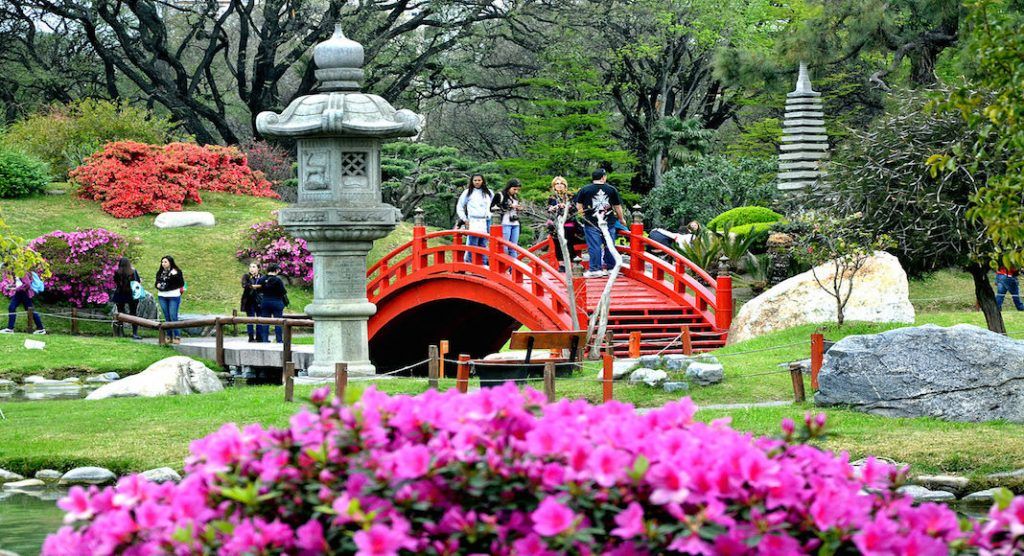
As a living expression of the friendship between Japan and Argentina, the Japanese Garden in Buenos Aires was built in honour of the Crown Princes of Japan during their visit to Argentina in May 1967. Since then, it has grown to become a very important cultural site representing the ties between both nations.
Often described as a “little Japan in Argentina,” Buenos Aires’ Japanese Garden has enchanted visitors with its tranquility and oriental beauty since its opening in 1967. Located in the Palermo neighborhood, it is the largest Japanese-style garden outside of Japan and attracts both tourists and locals looking for an oasis of peace amidst the urban hustle and bustle.
The creation of the Japanese Garden was promoted by the Japanese community in Argentina and later donated, through the Japanese Embassy, to the Government of Buenos Aires. This gesture of generosity was a thank you from the Japanese people to Argentina for having welcomed Japanese immigrants in difficult times.
The garden was conceived as a meeting place for Prince Akihito (who would later become the Emperor of Japan) and Princess Michiko during their historic visit to Argentina in May 1967. This was a pivotal event, as it marked the first time a member of the Japanese imperial family visited the country. The park was officially opened on May 17, 1967, and has since become a cultural and natural landmark in Argentina.
One of the most remarkable aspects of this beautiful place is how its landscape transforms with the changing of the seasons. Each time of year offers a unique experience and a new beauty.
In July, cherry trees blossom, filling the garden with delicate pink flowers, while in summer, vibrant violet water lilies adorn the ponds. In autumn, ginkgo biloba trees turn golden, and in September, beautiful azaleas begin to bloom. Alongside these Japanese plants, native trees such as Palo Borracho and Tipa complement the landscape, uniting both cultures through nature.
Perhaps the most iconic elements of the garden are its bridges, each of them charged with deep symbolism. They represent the passage from one world to another, offering a literal but also metaphorical journey to visitors.
The so-called “God Bridge” represents the path to paradise and is designed to be difficult to cross. This is because it symbolizes the challenges one must face in order to attain enlightenment. Then we have the “Truncated Bridge” which leads to the island of miracle remedies and evokes a sense of healing and renewal. Finally, the “Zigzag Bridge” symbolizes life’s choices, reminding people who cross it of the unpredictable paths that must be taken.
These bridges, combined with abundant vegetation and tranquil water fountains, create a calm atmosphere that invites relaxation and reflection.
The Japanese Garden is a Zen garden. This means that it is specifically designed for meditation and contemplation. According to Japanese philosophy, spaces that promote natural harmony and silence are essential to achieving the deep relaxation necessary for meditation. Every element of the garden, from the arrangement of trees and plants to the flow of water and carefully placed stones, has been designed to promote tranquility and peace of mind.
It is a place where visitors can stop, take a deep breath and immerse themselves in the calm rhythm of nature, away from the noise and distractions of the modern world.

In 1977, the garden was redesigned under the direction of landscape engineer Yasuo Inomata. This further enhanced its beauty and cultural value.
In addition to its natural features, the garden now includes a cultural center, where tourists can sample Japanese cuisine at its traditional restaurant, as well as a nursery where bonsai plants can be purchased. Visitors can also feed the koi fish swimming in the ponds or browse the gift shop, which sells Japanese crafts and souvenirs.
Over the years, the Japanese Garden has become a green lung for Buenos Aires, providing a peaceful refuge for the city’s inhabitants. It is not just a park, but a cultural icon that encourages the appreciation of both Argentine and Japanese heritage.
In 2004, the Buenos Aires Tourism Department declared the Japanese Garden a “site of tourist interest,” recognizing its cultural and ecological value. Later, in 2008, the National Executive Branch declared it a “site of historical and artistic interest to the Nation,” ensuring its preservation for future generations.

Source: https://reporteasia.com/cultura/2024/09/20/jardin-japones-buenos-aires-rincon-paz/

